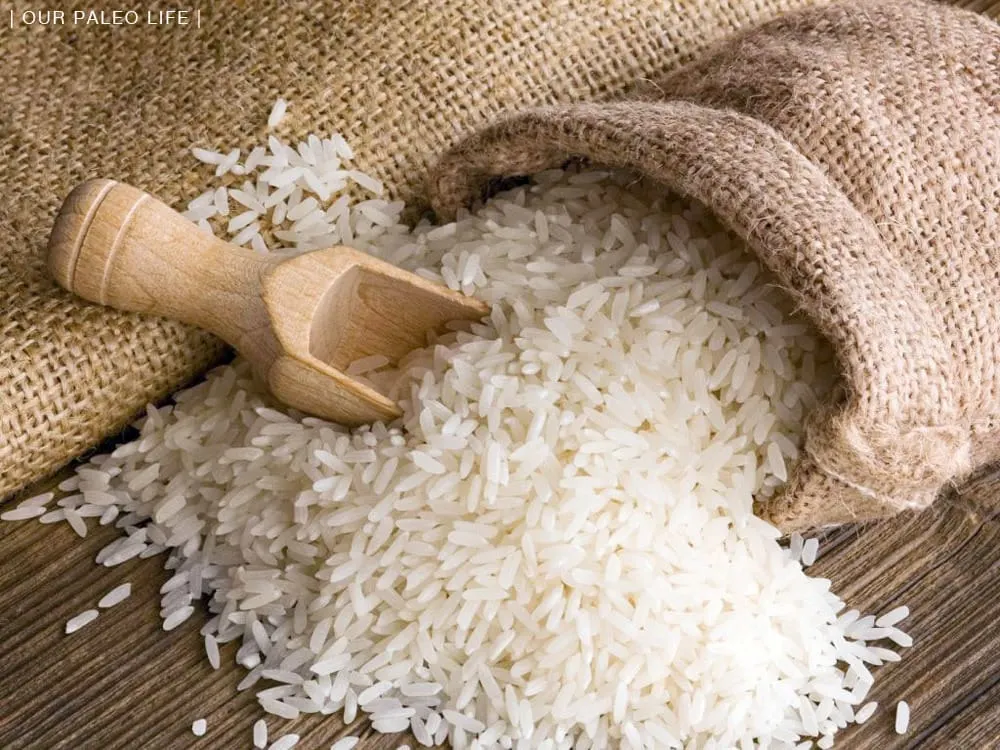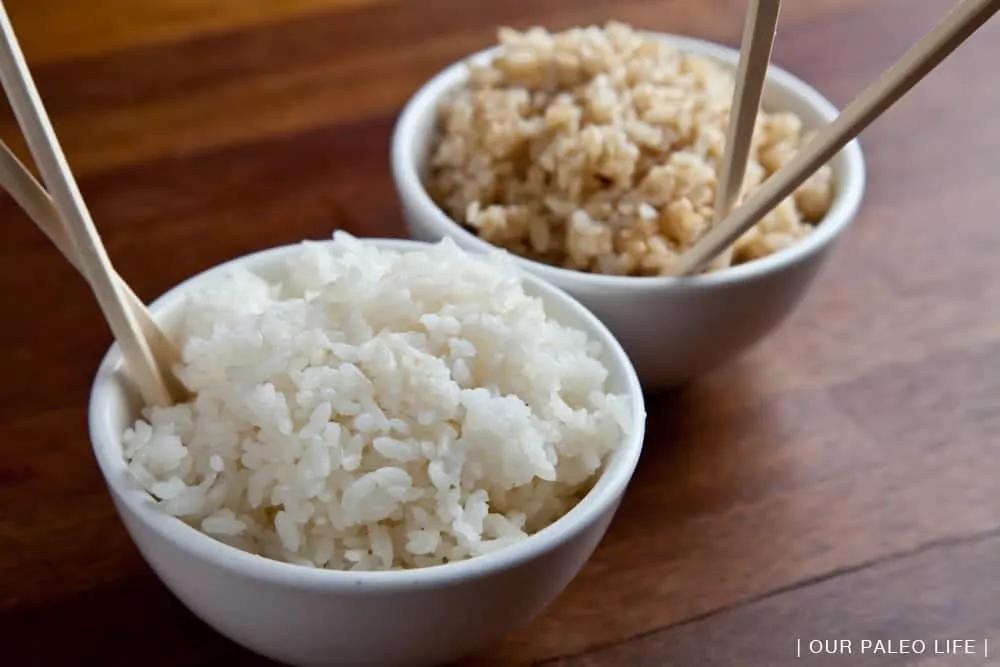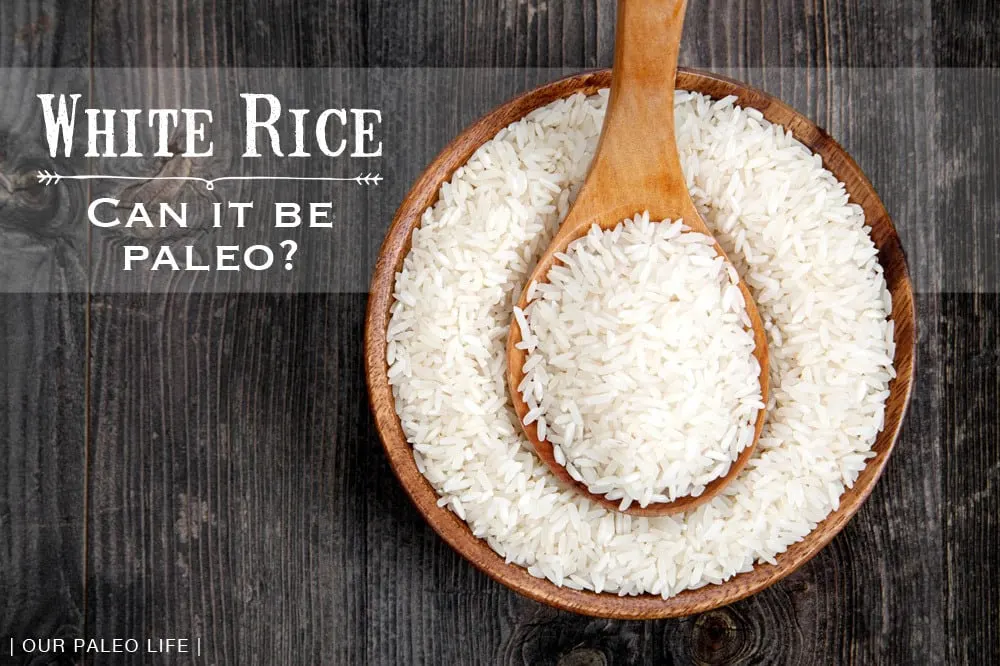We’re so pleased to have the wonderful Nikki Jencen as our first guest blogger on Our Paleo Life. Nikki is a certified holistic health coach and knows about all things grain-free. Keep an eye out for her wonderful and informative posts each month.
Can white rice be Paleo?
What’s the first answer that pops into your head? No, of course not. When we describe the essence of what Paleolithic eating is we should automatically think avoid all grains, sugar, legumes, dairy, etc. But what is rice? Is rice a grain or a starch? Before I answer that let’s explore the history of rice, different types of rice, and why it may be able to fit into a Paleo diet.

HISTORY OF RICE
Rice crops date back to about 2500 B.C. and originate in China. Rice also known as (Oryza Sativa) is a cereal grain of the grass family that grows 2-6 ft tall with round, jointed stems. In Chinese, the word “rice” and the word “food” are synonymous. Which means at the time rice was being cultivated, so was the Chinese language. Rice is free of the protein gluten but contains different protein chains called amino acids. Amino acids are critical for muscle building and repair. It’s a good thing that rice is free from gluten which causes havoc throughout our body and is used in many gluten free foods. Rice is actually a grass that sprouts clusters of spikelets instead of flowers, which holds one grain of rice (endosperm of the rice seed). All rice varies in color, shape, flavor and size. Rice is a staple food for many countries; it was first cultivated in China not before long it was brought to Sri Lanka and other countries such as Africa. The crop flourishes in subtropical climates and is estimated that half the world’s populations subsists on rice. So, I propose this question, before westernized food entered into Asia, the people of the continent were slim and healthy, so what makes it so bad for us? Let’s dig a little deeper.
DIFFERENT TYPES OF RICE
There are more than 40,000 different types of rice depending on the region that it’s grown in. To keep this short and sweet, I’ll just name a few. All white rice was originally brown and is then chemically or milled to remove the outer husk. White rice is what is left after the bran and germ are removed, this is where most of the nutrients reside. Some rice is enriched with vitamins and minerals that were removed during the milling process. Different types of rice include: wild, basmati, black or forbidden, Arborio, red rice, jasmine etc.

BROWN RICE – the healthier choice? Let’s take a look at the nutrient density (keep in mind that not all nutrition facts will be the same)
WHITE RICE – the bad choice? When you compare the two types of rice, they are almost nutritionally identical. Most white rice is enriched, which is the process of adding back in the vitamins and minerals.
Let’s take a deeper look into why rice is supposedly a no-no in the Paleo diet. Brown rice contains the bran and germ which means the nutrient density is going to be higher than white. Brown rice contains phytate or phytic acid which is NOT digestible to humans, and blocks our ability to absorb vital minerals such as zinc, calcium, magnesium and iron. It has lectins…But unlike gluten lectins it does not cause malicious harm to our body. The type is called Haemagglutinin-lectin which binds to carbohydrate receptors and block nutrient absorption. The good news is once the rice is cooked it deactivates lectin’s toxicity. People have been trying to figure out how to release these anti-nutrients from the grain using many different methods for example, soaking and fermenting the grain or parboiling (partially boiling, drying and milling process). The good nutrients that brown rice contains are: choline, vitamin K, folate, selenium, calcium, magnesium, and potassium. Unfortunately for us humans, phytic acid will block most of these nutrients.
Essentially, white rice is brown rice that is milled and processed to remove the outer bran and germ. So after the bran and germ are removed from the brown rice, what’s left nutritionally? Actually quite a bit more than what I thought. According to http://nutritiondata.self.com, this credible website reveals that folate, potassium, calcium, magnesium, and oddly enough fluoride goes from 0 mcg to 64.9 mcg which may be caused through the mulling and extraction of the husk. This nutrition data may be after enrichment which would make these facts null and void. Another good point about white rice is that when the bran and germ are omitted it’s less toxic to your body, easier to digest, and nutrients are more absorbable, hence, making white rice not as bad as it’s ugly reputation.

WHY WHITE RICE MAY BE ABLE TO BE PALEO
In actuality, white rice won’t ever be Paleo. Sorry. The reason is because a grain is still a grain, and sugar is still sugar. White rice is more or less a nothing food. Paleo prides itself on clean eating, and eating what our Paleolithic ancestry ate. Processed foods don’t fall into the Paleo ideology. I consider white rice to be a processed food, since it has to go through a process to remove the bran and germ and furthermore to be enriched with vitamins and minerals. Most removal of the bran isn’t through a chemical process, which is good, but some are…which is a little scary. The research leads me to believe that it’s better to eat white rice over brown which is contrary to popular belief. I love going against the grain! Most experts would say to eat white rice with a fibrous vegetable and a protein; this will diminish the starch effect. White rice is all starch which turns into a sugar almost immediately in the digestive system. The goal with eating brown rice is it slows down the insulin production which is better in regards to glycemic index. On the other hand, white rice merely does the same thing when coupled with a fibrous vegetable and protein. White rice is a safer choice due to the fact it will never block vitamins and minerals or irritate your digestive system like brown rice will.
All in all, rice isn’t the greatest food to eat when following a Paleo diet. Rice is indeed a grain AND a starch. Rice in its whole form is a grain; once the bran and germ are removed it becomes a starch which immediately turns into a sugar if not coupled with a protein. If you had to choose between white or brown rice while out to dinner at PF Changs, choose white if you’re so inclined. This should be great news for the sushi lover too. Of course, the best and most Paleo choice is to say no to the rice but sometimes, you just have to live a little.

Peggy Knowles
Sunday 28th of February 2021
Thank you for this information. I googled no grains except white rice just to see what I could learn. I already know that white rice is not good for me but I cannot tolerate any other grain and gluten and wheat are the worst. And no brown rice except gluten-free brown rice pasta and gluten-free brown rice flour. Pasta in general is not good for me. But the gluten-free brown rice flour to make flat bread is good for me. I can't tolerate any dairy. No butter no cheese. I can tolerate BUFF buffalo Mozzeralla cheese. All tree nuts are a no. No eggs or poultry. All hard beans are a no, all corn including popcorn is a no. No onions or peppers. Horribly allergic to bananas, causes hullicinations. I'm having trouble with lettuce and cabbage. Any suggestions would help. Thank you. I eat a lot of beef sad broccoli. And love broccoli salad.
universitas keperawatan di jakarta
Wednesday 22nd of November 2017
Hi, I do believe this is a great site. I stumbledupon it ;) I may come back yet again since I book marked it. Money and freedom is the greatest way to change, may yoou be rich and continue to help others.
materi kuliah manajemen informatika
Alexandra
Tuesday 25th of October 2016
Hi there! Thanks very much for this article. I recently put my family on paleo for my dad's sake (he is pre-diabetic). My father is Indian, however, and worships at the alter of basmati rice! I am struck by this finding that combining white rice with protein and fibrous vegetables slows down insulin production. In Indian cooking (at home, not in a restaurant), rice is rarely eaten alone -- in fact it is almost always coupled with both a protein (usually in the form of lentils), and one or two vegetable dishes (okra, spinach, mustard greens, etc.). Obviously we have eliminated the lentils and the rice, but I am curious about the sources of the studies you researched, and what types of examples of protein and vegetables are paired up with rice. I would greatly appreciate it if you could send me a link as I had trouble finding the information myself! Also, I am assuming fibrous in this sense refers to high-fiber vegetables on not fibrous as in stringy (such as okra)? Thanks in advance and keep up the nice work! Cheers from Florida :)
Reina
Wednesday 20th of September 2017
To Alexandra, It is really confusing indeed to know which information is reliable, especially when the sources are not cited. Some places we read that rice is ok for Paleo diets, etc. I found an article on a french canadian website that we have here in the province of Québec, Canada and white rice, basmati rices are gluten free. http://www.passeportsante.net/fr/Actualites/Dossiers/DossierComplexe.aspx?doc=alimentation-sans-gluten-quoi-manger-pas-de-gluten-dans-le-riz Hope I'm not too late with the information and that it helps. Namaste.
Rheannon
Monday 19th of October 2015
Great post. I've been paleo for a while now and I started seeing rice in some paleo dishes. I didn't think it was paleo and your post definitely cleared that up. Thanks.
Justine
Thursday 1st of January 2015
Just found this site. Very nice, love the kids meal. Thank you